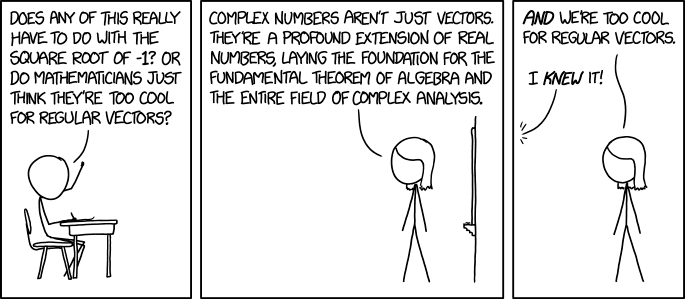Complex numbers in the context of CG1111A is not too challenging.
With enough practice, it is easy to solve complex number questions in CG1111A.

Useful Formulae
Consider an arbitrary complex number $x(t)$:
$ \text{1. Cartesian form: } x(t) = a(t) + jb(t) \\ ~ \\ \text{2. Polar form: } x(t) = r(t)e^{j \theta(t)} \begin{cases} r(t) = \sqrt{a^2 + b^2} \\ \theta(t) = \angle{x} = tan^{-1}(\frac{b}{a}) \end{cases} $
Phasor Arithmetic
Additional reading with more properties.
Products are phase sums
$ X\angle\phi_x \cdot Y\angle\phi_y = (X\cdot Y) \angle(\phi_x + \phi_y) $ Note: The dot refers to regular product (multiplication of 2 numbers).
Divisions are phase divisions
$ \frac{X\angle\phi_x}{Y\angle\phi_y} = (X/Y) \angle(\phi_x - \phi_y) $
Inversions
$ X\angle 0 = -X\angle \pi $
General Addition and Subtraction
Note: arctan is the same as tan^-1!
$
C_1 = x_1+jy_1 , ~
C_2 = x_2+jy_2 \\ ~ \\
C_1\pm C_2 = (x_1\pm x_2) + j(y_1 \pm y_2) \\ ~ \\
C_1\pm C_2 = \sqrt{(x_1\pm x_2)^2 + (y_1\pm y_2)^2} + \arctan((y_1\pm y_2)/(x_1\pm x_2)) \square
$
Please verify the above on your own!
I used rectangular form since it’s simpler and more direct, but if you can derive using polar or cos/sin form, it should work as well.
General Properties and shortcuts
Challenge: Prove that the following identities are true.
Proofs1 and hints2 3 are appended below.
$ \text{1. } \frac{1}{j} \equiv -j \\ ~ \\ \text{2. } \frac{1}{(n \pm mj)} \equiv \frac{n}{(n^2+m^2)} \mp \frac{mj}{(n^2+m^2)} ~ \\ ~ \\ \text{3. } \sin (\omega t + \phi) \equiv \cos(\omega t + \phi - 90^\circ) \\ $
Extra: Why j, not i?
In the engineering world, i is often used to describe equations or physical phenomena such as your transient current. Recall that it is $i(t)$. To avoid ambiguity, we use j instead.